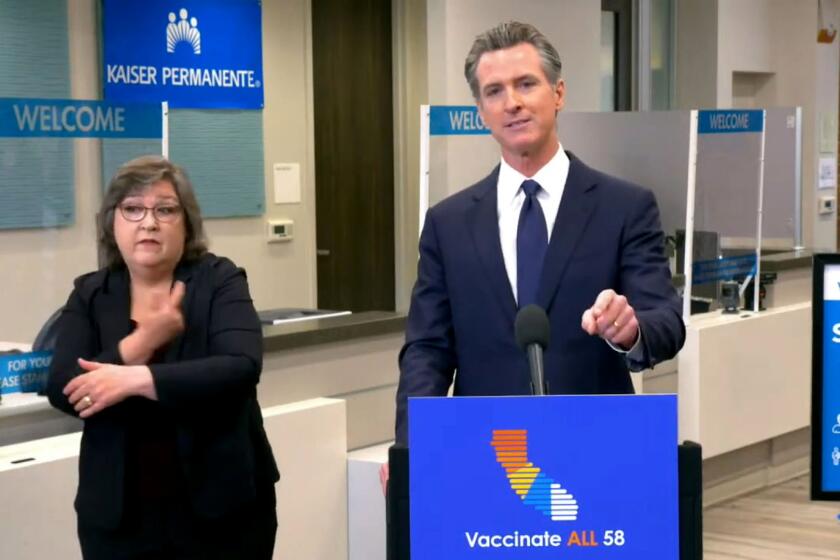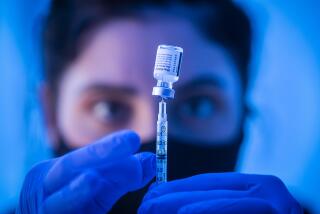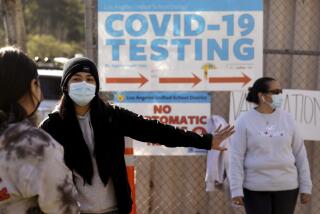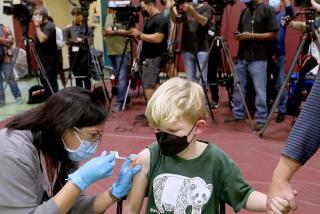Thousands of state workers are unvaccinated. California isn’t testing half of them for COVID as required
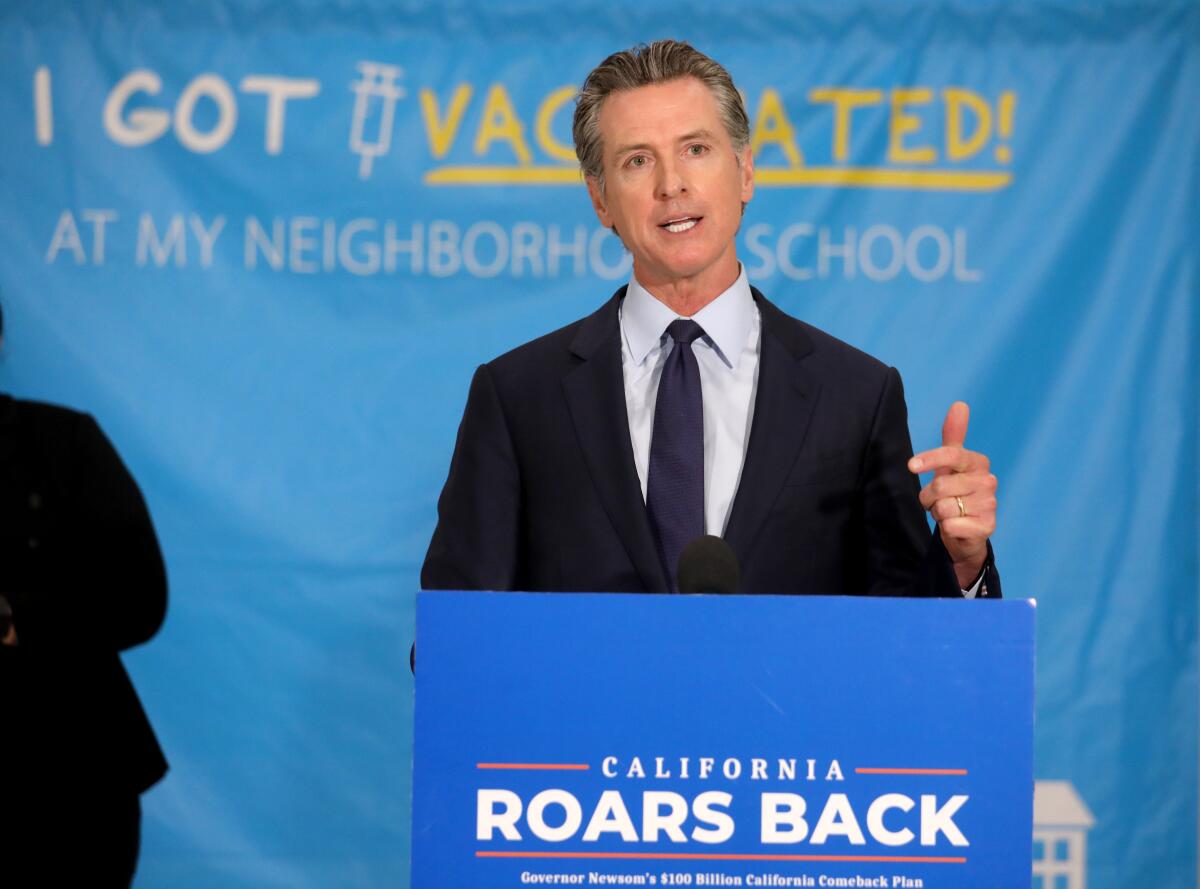
- Share via
SACRAMENTO — Three months after Gov. Gavin Newsom required state workers to be fully vaccinated against COVID-19 or undergo weekly testing, his pledge that California government would lead by example has not been fulfilled: Many public agencies face low vaccination rates, and most state-run workplaces have failed to test unvaccinated employees.
At the California Department of Forestry and Fire Protection, for example, fewer than a third of employees have provided proof they are fully vaccinated, while 6,700 employees are either not vaccinated or have declined to provide their status. Cal Fire said it is testing just 75 employees.
The Department of Motor Vehicles, where 59% of employees are fully vaccinated, has about 3,600 unvaccinated staffers working in offices across the state who are required to be tested weekly. But only 411 of them are being tested, a DMV spokeswoman said.
Some departments have failed to report vaccination rates or testing information altogether, but the California Department of Human Resources said the data it has received show that roughly half of 59,000 unvaccinated state employees were tested as required during the first week of October.
“If we don’t have the warning system of testing, then we need to reconsider what we are doing,” said Dorit Reiss, a law professor who specializes in vaccine policies at the UC Hastings College of the Law. “Testing is not a great substitute for vaccinating, but it’s a great backup and better than nothing.”
California government and healthcare employees will soon be required to show proof they’ve been vaccinated against COVID-19 or be tested regularly.
The state’s struggle to implement Newsom’s mandate comes as workplaces across the nation are imposing deadlines for workers to provide proof of vaccination or risk losing their jobs.
Last week, enforcement of Washington Gov. Jay Inslee’s COVID-19 vaccine mandate resulted in 3% of state workers — about 1,900 employees — resigning or being fired. The Biden administration has also announced stringent new requirements, including pending labor regulations that would require businesses across the country with 100 or more employees to ensure that workers are fully vaccinated or undergo weekly testing.
Newsom’s Aug. 2 deadline for California government workers, however, was largely ignored without consequence. Overall, 66% of the state’s employees provided proof they are vaccinated, according to data from the state Department of Human Resources. Statewide, 74% of residents 18 and older are fully inoculated.
“This is problematic,” said Dr. Monica Gandhi, an infectious-disease expert and professor of medicine at UC San Francisco. “The entire point of Gov. Newsom being the first governor to say state employees should be vaccinated is because these employees are public interfacing, and the vaccine protects them and the public they serve. Then, if the testing component isn’t being universally applied, you are defeating the point.”
Under the state’s mandate, employees who work remotely full time are not required to provide vaccination proof — although many have — and do not have to undergo weekly testing. A little more than half the state’s 10,000 California Highway Patrol employees have provided proof they are vaccinated, a spokeswoman for the department said. Some testing sites have been opened, including at CHP’s headquarters, but not all.
“Since we started testing, we have completed 2,088 tests with two confirmed positive results,” CHP spokeswoman Fran Clader said in a statement.
The department did not respond to a request for details on how many employees are being tested weekly.
At Cal Fire, testing is available at the department’s headquarters, where 75 employees are being tested weekly, said spokesman Nick Schuler. Plans are underway to add testing at six additional sites in early November.
“Demands of wildfire response in July, August and September slowed our progress implementing testing, but we now expect to have several of the testing centers up and running within weeks,” Schuler said.
The rate of positive results for departments that are testing has remained low. A DMV spokeswoman said there were four positive tests among 2,070 given to date. And among all departments reporting results to the state’s human resources agency, there were 155 positive tests out of 31,534 completed during the week of Oct. 4.
Public health officials, however, have warned that cases can climb again if residents are not vigilant in protecting against transmission of the coronavirus. New infections and COVID-19 hospitalizations have been steadily falling for weeks, but daily death counts have remained relatively high, Times data show. Over the last week, the state has averaged 5,203 new cases and 105 deaths per day. To date, COVID-19 has killed more than 70,000 Californians.
Dr. Mark Ghaly, secretary of the California Health and Human Services Agency, urged hesitant state workers to get vaccinated in a letter last month, writing that he had a wake-up call when reading about “another tragic, preventable loss of a member of our state family to COVID-19, leaving a wife and two young children behind.”
“I realized that I haven’t done enough,” Ghaly said. “I should say, we haven’t done enough.”
Newsom announced the vaccine mandate for state workers at the same time he implemented one for healthcare workers.
“As the state’s largest employer, we are leading by example and requiring all state and healthcare workers to show proof of vaccination or be tested regularly, and we are encouraging local governments and businesses to do the same,” the governor said in July.
So far, the push to vaccinate millions of healthcare workers appears to have been more successful, a likely result of the mandate not allowing for those employees to opt for weekly testing in lieu of vaccination unless they had an exemption. Healthcare workers were allowed medical and religious exemptions, which have been granted subjectively in different parts of the state, according to Times reporting. Many hospitals said the state mandate boosted vaccination rates, with a hospital system in Kern County reporting that its rates jumped to about 90% from about 60%.
The vaccination rate for state workers has seen a much smaller increase of just 2 percentage points to 66% over the course of one week, the state’s Human Resources department said. However, not all departments are reporting data for their staff regularly — or in some cases, at all.
Nearly one-third of all state agencies reported employee vaccination rates lower than 74%, the statewide rate among adults for inoculation. At the state’s Human Resources department, which is tasked with monitoring compliance with the mandate, 62% of the agency’s workforce is vaccinated.
“That didn’t surprise me,” said Eraina Ortega, director of the department. “The vast majority of our employees are in the Sacramento region, and that number seems in line with the region.”
Ortega said many state employees are still telecommuting and do not feel the urgency to provide their vaccination status if they won’t be required to undergo regular testing.
“Not all employees want to provide the vaccine verification before the testing is set up,” Ortega said. “In my own department, I heard from people early on that they have to get the vaccine information in, but they are teleworking and so they haven’t done it yet.”
Ortega said that testing thousands of unvaccinated state workers is a massive undertaking and that the effort has been slowed by supply shortages. She said there is no hard deadline for when departments have to begin testing unvaccinated employees. So far, she said, 48 out of 152 state departments have testing up and running at some or all of their locations.
“The scaling we anticipated is happening,” Ortega said. “I feel we have done a pretty good job of doing this entirely with state staff.”
Since the beginning of the COVID-19 pandemic, Newsom has championed some of the nation’s strongest coronavirus restrictions, but he’s also faced criticism that his vaccine orders have been inconsistent. The governor fought attempts to require corrections employees to be vaccinated against COVID-19, despite recommendations from a federal court-appointed receiver overseeing medical care inside prisons who argued that a strict mandate is necessary to prevent major outbreaks and deaths. Currently, all prison staff who work in healthcare settings are required to be vaccinated.
The California Department of Corrections and Rehabilitation has a vaccination rate of 63% among its 66,000 employees, according to the agency’s data. Currently, unvaccinated prison staffers must be tested twice weekly.
The data collected by the human resources agency do not include information from Newsom’s office, which operates independently. A spokeswoman for the governor said all but one of the 148 employees in Newsom’s office are vaccinated, with that person subject to the weekly testing protocol.
Newsom spokeswoman Erin Mellon said the state is ramping up testing efforts among California’s many departments.
“It has been a monumental effort to organize regular, free testing across the state workforce of more than 200,000 people,” Mellon said in a statement.
Rob Lapsley, president of the California Business Roundtable, said the problems arising from the state’s mandate for its employees show that further scrutiny and transparency are necessary so that businesses are able to better understand the logistical hurdles they, too, may face.
“The business community is watching the state’s whole implementation very carefully because the mandate and testing protocols have real-life implications for if and when a mandate comes from the state or federal government for the private sector,” Lapsley said. “To the governor’s credit, he’s having the state lead on this so there can be some lessons learned by them going first.”
More to Read
Sign up for Essential California
The most important California stories and recommendations in your inbox every morning.
You may occasionally receive promotional content from the Los Angeles Times.
